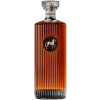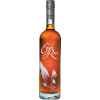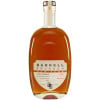About Cane & Abe Small Barrel Rum
After the brown sugar cane is mixed together with water and yeast, the mash is fermented at room temperature for approximately two weeks before Greenawalt distills it in his 220-gallon copper-pot still. "It's a new still made by Col. Wilson down in the Ozark Mountains," says Greenawalt. "All he does is make stills."
After distillation, the rum is aged in charred oak barrels ranging in size from 5 to 30 gallons. New and used barrels are used in order to ensure that the rum achieves its characteristic smooth, robust flavor. After aging the rum for just under a year, each bottle is filled and labeled by hand, before being signed by Greenawalt himself.
"Most rums are sweetened, especially golden or dark rums. Most rums will add either caramel or molasses to enhance the color and make it sweeter,"explains Greenawalt, whose rum is unsweetened after distillation. The brown sugar cane he uses to distill Cane & Abe Small-Barrel Rum creates a naturally sweet flavor profile that doesn't require artificial additives or ingredients.
Pay tribute to the Wisconsin 8th with this award-winning rum today!
About Cane & Abe
Five months after the first shots were fired at Fort Sumter in April 1861, marking the beginning of the American Civil War, 870 men from Wisconsin were mustered into federal service and joined the Union Army. Together, the men formed the 8th Regiment of the Wisconsin Volunteer Infantry. Before the war was over, the Wisconsin 8th would fight in over 30 battles and suffer more than 275 casualties. Their mascot, which accompanied the regiment into battle, was a bald eagle named Old Abe, who was later adopted as the mascot of the U.S. Army's 101st Airborne Division.
In downtown Madison, Wisconsin, Old Sugar Distillery's master distiller, Nathan Greenawalt, pays homage to the Wisconsin 8th with Cane & Abe Small-Barrel Rum. Rather than using molasses from the Caribbean or Central America for his rum, Greenawalt imports brown cane sugar harvested in Hawaii and Louisiana.
About Rum
Rum history allegedly started in the Carribiens in the 17th century when they started to ferment and distill molasses, a byproduct of sugar production. Most of the Rum is aged in oak or ex-wine casks, giving its color and flavor.
We distinguish between 4 different Rum categories, where white or unaged rum is mainly used in cocktails, while dark, spiced, and añejo (aged) rum are mostly enjoyed neat.
Check out our impressive selection of rums, find your new favorite in Top 10 rums, or explore The best gifts for rum drinkers.











